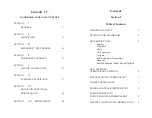
SECTION 5
CESSNA
PERFORMANCE
MODEL 172RG
With this factor included, the fuel estimate would be calculated as follows:
Using a similar procedure for the distance during climb results in 23
nautical miles.
The resultant cruise distance is:
Total distance
425
Climb distance
-23
Cruise distance
402 Nautical Miles
With an expected 10 knot headwind, the ground speed for cruise is
predicted to be:
132
-10
122 Knots
Therefore, the time required for the cruise portion of the trip is:
The fuel required for cruise is:
3.3 hours
8.8 gallons/hour = 29.0 Gallons
A 45-minute reserve requires:
The total estimated fuel required is as follows:
Once the flight is underway, ground speed checks will provide a more
accurate basis for estimating the time enroute and the corresponding fuel
required to complete the trip with ample reserve.
5-6
1 July 1979
CESSNA
SECTION 5
MODEL 172RG
PERFORMANCE
LANDING
A procedure similar to takeoff should be used for estimating the
landing distance at the destination airport. Figure 5-10 presents landing
distance information for the short field technique. The distances corres-
ponding to 2000 feet pressure altitude and a temperature of 30°C are as
follows:
Ground roll
705 Feet
Total distance to clear a 50-foot obstacle
1465 Feet
A correction for the effect of wind may be made based on Note 2 of the
landing chart using the same procedure as outlined for takeoff.
DEMONSTRATED OPERATING TEMPERATURE
Satisfactory engine cooling has been demonstrated for this airplane
with an outside air temperature 23°C above standard. This is not to be
considered as an operating limitation. Reference should be made to
Section 2 for engine operating limitations.
1 July 1979
5-7















































